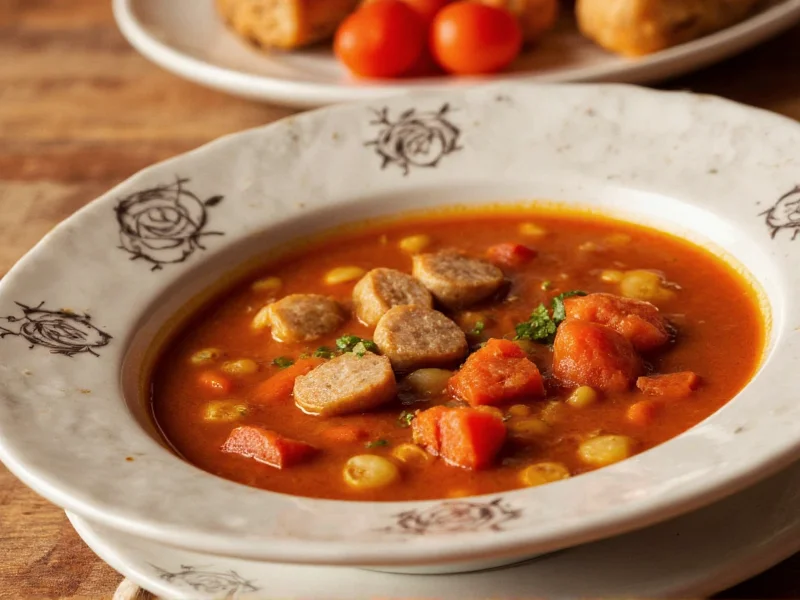The Essential Guide to Crafting Perfect Sausage Soup
Creating exceptional sausage soup requires understanding ingredient synergy and proper technique. This versatile dish has roots in European culinary traditions, particularly German, Polish, and Italian cuisines, where resourceful cooks transformed simple ingredients into nourishing meals. Modern home chefs can master this comfort food by focusing on quality components and thoughtful preparation.
Choosing Your Foundation: Sausage Selection Matters
The sausage variety fundamentally shapes your soup's character. Consider these options for different flavor profiles:
| Sausage Type | Flavor Profile | Best Soup Applications |
|---|---|---|
| Italian Sausage | Garlicky, fennel-forward, mildly spicy | Tomato-based minestrone, white bean soup |
| Smoked Kielbasa | Robust, smoky, slightly peppery | Hearty potato soup, cabbage soup |
| Breakfast Sausage | Sweet sage, subtle spice | Creamy corn chowder, squash soup |
| Chorizo | Rich paprika, garlic, deep smokiness | Bean stews, tomato-based soups |
Professional chefs recommend browning sausage thoroughly before adding liquid—this crucial step develops fond (those flavorful browned bits) that forms the flavor foundation. For homemade sausage soup recipe success, avoid pre-cooked sausages with excessive fillers that can make your broth cloudy.
Building Flavor Layers: The Soup Construction Process
Exceptional sausage soup follows a precise sequence that maximizes flavor development:
- Sear the sausage in a heavy-bottomed pot until deeply browned (reserve 1-2 tablespoons of fat)
- Sweat aromatics (onions, celery, carrots) until translucent but not colored
- Add tomato paste and cook 2 minutes to eliminate raw flavor
- Deglaze with 1/2 cup dry white wine or apple cider vinegar
- Incorporate broth (4-6 cups low-sodium chicken or vegetable)
- Add hard vegetables (potatoes, turnips) and simmer 15 minutes
- Add quick-cooking elements (greens, beans, pasta) during final 5-10 minutes
This method creates the ideal sausage soup cooking time balance—sufficient to develop flavors without overcooking ingredients. For creamy sausage and potato soup variations, mash 1/3 of the potatoes against the pot wall during the final simmer to naturally thicken the broth.
Dietary Adaptations Without Sacrificing Flavor
Modern sausage soup recipes accommodate various dietary needs while maintaining depth of flavor:
- Gluten-free sausage soup options: Use cornstarch slurry instead of flour for thickening; verify sausage ingredients as many contain breadcrumbs
- Lower-sodium versions: Simmer sausage in water first to remove excess salt, then use homemade low-sodium broth
- Vegetarian adaptation: Substitute smoked mushrooms and liquid smoke for sausage flavor; add white beans for protein
- Keto-friendly preparation: Replace potatoes with cauliflower and increase healthy fats through olive oil infusion
When preparing healthy sausage soup variations, remember that fat carries flavor—don't eliminate all fat content as this diminishes taste complexity. Instead, focus on quality fats from the sausage itself rather than adding excessive oil.
Proven Techniques for Soup Success
Seasoned chefs employ these often-overlooked methods to elevate basic sausage soup recipes:
- Acid balance: Finish with lemon juice or vinegar to brighten rich flavors (1-2 teaspoons per quart)
- Herb infusion: Tie fresh thyme, rosemary, and bay leaves in cheesecloth for easy removal
- Temperature control: Maintain gentle simmer (180-200°F), not rolling boil, to prevent ingredient breakdown
- Resting period: Allow soup to sit 15 minutes off-heat before serving for flavors to marry
For those seeking easy sausage soup for beginners, start with a simple mirepoix base (onion, carrot, celery) and one type of sausage before experimenting with complex variations. The ideal sausage soup consistency should coat the back of a spoon—too thin and it lacks body, too thick and it becomes stew-like.
Serving and Storage Recommendations
Maximize your sausage soup experience with these professional suggestions:
- Serving temperature: 165-175°F—hot enough to be comforting but not scalding
- Garnish pairings: Fresh parsley, grated Parmesan, or a drizzle of high-quality olive oil
- Accompaniments: Crusty bread, simple green salad, or roasted vegetables
- Refrigeration: Store in airtight container for up to 4 days (flavors improve overnight)
- Freezing: Portion in freezer bags flat for up to 3 months (thaw in refrigerator)
Reheating sausage soup requires care—gentle warming over medium-low heat preserves texture. Add a splash of broth if the soup has thickened during storage. The best sausage soup reheats maintain their ingredient integrity without becoming mushy.
Mastering Sausage Soup Variations
Regional adaptations showcase sausage soup's versatility across culinary traditions:
- German-inspired: Use smoked kielbasa with sauerkraut, caraway seeds, and juniper berries
- Italian wedding soup style: Combine Italian sausage with escarole, acini di pepe, and Parmesan rind
- Midwestern hotdish: Layer sausage soup with tater tots for a casserole hybrid
- Creole adaptation: Incorporate andouille sausage with the "holy trinity" (onion, celery, bell pepper)
When developing your signature sausage soup recipe, consider seasonal ingredients—asparagus and peas in spring, tomatoes and zucchini in summer, root vegetables in fall and winter. This approach creates naturally rotating variations that keep your cooking exciting throughout the year.











 浙公网安备
33010002000092号
浙公网安备
33010002000092号 浙B2-20120091-4
浙B2-20120091-4